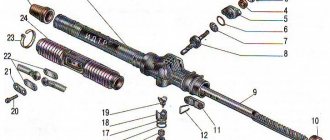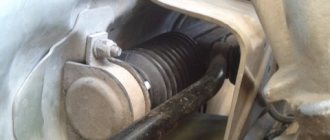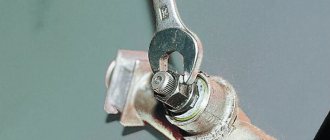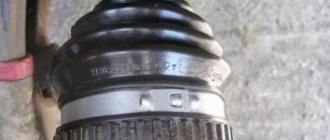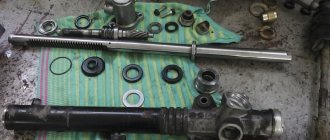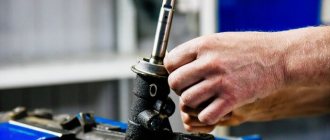Hello, dear readers of the Kak-Kupit-Auto.ru . A couple of months ago, my five-year-old Kalina suddenly developed noticeable play in the steering wheel . Until that moment, the steering was fine with me, and therefore it never occurred to me to carry out maintenance on the steering rack , but play in the steering arose, and then I decided to figure out its reasons and find a way to eliminate this shortcoming.
Having studied the issue, I learned that loud drumming sounds from the front suspension when driving over small irregularities can also be caused by a faulty steering rack, and not by parts of the front suspension. And indeed, after repairing the rack, all the noise disappeared. It turns out that it wasn’t the balls, or the silent blocks, or even the racks that were drumming, it was just the rack dangling in the body like a pencil in a three-liter jar.
Having disassembled Kalina's steering rack , I realized that it was in vain that I had not carried out preventive maintenance earlier. If I knew what , how and why to do to keep the rack in working condition , I would do it after another 3-4 years of operation. But then I didn’t have this information yet, but now it has appeared, and I hasten to share it with you, dear readers!
How to replace the boot on the steering rack of a VAZ 2110
Steering rack boot
The performance of the steering rack mechanism is primarily determined by reliable protection from dirt, moisture and other debris. For this purpose, a special corrugated rubber cover (boot) is provided. The VAZ-2110 steering rack will last a long time if you regularly monitor the condition of the boot. Periodically, using a bright flashlight, check the integrity and tightness of the protective cover and then you can avoid problems with steering rack repair for a long time. If any defects are found in the boot, it should be replaced immediately. Replacing steering rack boots is a rather troublesome procedure. However, this activity can be done with your own hands. To do this you will need a tool, a new boot, a couple of hours and desire. This article provides detailed instructions on how to replace the steering rack protective cover yourself.
We prepare the car and necessary materials
To replace the boot, you need to prepare the following tools:
In addition to a new boot, you should stock up on clamps for attaching the adsorber, lithol, WD fluid and gloves. We will also need a jack and two supports for the car (“goats”). Replacing the steering rack boot on a VAZ 2110 should be done on a cold engine, as there is little space and there is a chance of getting burned or scratched your hands. Therefore, protective gloves will come in handy. It would be a good idea to wash the car well before repairing. To make it easier to replace the boot, you should use a pit or a pair of stands (“goats”). First, set the car to the parking brake. Be sure to put chocks or blocks under the rear wheels. Then we jack up the car and install supports under the front end so that it is convenient to get to the steering mechanism.
Note: There will be no problems with bolts and nuts if they are pre-treated with WD fluid.
Removing protection
To replace the boot, you must provide access to the steering rack. First, we dismantle the engine protection. Then, using a 10mm wrench or a ratchet with a small wrench, unscrew the fastening of the rack protective screen from the manifold. One nut is at the bottom and two at the top.
Note: To make it easier to remove the screen, you must first rotate it 180 degrees and then pull it out.
Steering rack protective screen
Removing the old boot
To make it easier to continue working, you need to remove the adsorber. The adsorber mounting clamps, as a rule, cannot be removed. Their price is low, so we simply cut off the clamps in passages, then install new ones. After this, remove the steering rods in the following order:
- We flare the tie rod bolts using a screwdriver, hammer and pliers. Then use a 22 mm wrench or a ratchet with a wrench to unscrew them.
- We remove the steering rods from the rack.
Steering rod disconnected from rack
- Using a 13mm wrench, unscrew the steering rack from the right side, which is secured with two nuts at the top and bottom.
- We take out this fastener along with the side rubber of the steering rack.
- Remove the damaged boot.
Note: To make it more convenient to remove the boot, first slightly unscrew the steering rack on the left using a 13mm wrench.
We install a new boot
- Before installing a new boot, the steering rack on the VAZ-2110 must be well cleaned of dirt. Then lubricate it well with lithol. If the surface of the rack is well lubricated, the boot will be easier to install. The rubber cover should be put on carefully so as not to tear it. The boot must not be twisted.
New steering rack boot
- We put the tie rods with bolts back into the steering rack. Sometimes this can be difficult to do, especially if someone turned the steering wheel while removing the boot, but if this is not done, then installing the rods with bolts will not be difficult.
- Tighten the tie rod mounting bolts using a 22mm wrench or a ratchet with a wrench. After this, we roll the bolts using a hammer, screwdriver and pliers.
- We install the side elastic band and fastening.
- Using a 13 mm wrench or a ratchet, carefully tighten the steering rack fastenings on the right and left.
- We put the adsorber in place, screw it in with a 10mm wrench and secure it with clamps.
We put up protection
To make it easier to install the protective screen, first turn it upside down and push it through. Then we turn it 180 degrees to the desired position and screw it with a 10 key along with an elastic band. After replacing the boot is completed, we once again check the correct installation and prepare the car for a test drive.
Necessary tools to complete the work.
- Screwdriver. Useful for unscrewing the clamp screws. It can be flat or cross-shaped. It all depends on what screw the clamp is used with.
— Sometimes, to secure, you can use a plastic tie. And to cut it, they use a knife.
— The keys are designed to remove steering rods. Keys for different car models may vary.
— Solid oil or other viscous lubricant. Parts will be needed to lubricate after removing the boot to avoid corrosion.
— New clamps and anthers. Because those fasteners that were installed previously may be rusty, they need to be replaced for reliability. If the replacement takes place on a VAZ engine, then the boot here is made in the form of a cover. It covers the rack and steering rod. In this case, instead of four clamps, you only need two.
Regardless of the car brand, they have the same replacement principle. But, with some nuances that may affect the reliability of the element’s operation in the future.
Features of the steering rack with power steering
On a small part of VAZ-2110 cars, the steering rack was equipped with power steering (power steering). Structurally, it is slightly different from a regular rack (without power steering). The photo shows the hoses that ensure the operation of the hydraulic booster.
Steering rack with power steering complete with rods
Therefore, the procedure for replacing the boot on cars that have a steering rack with power steering has its own characteristics.
Preparing tools and materials
In addition to what was stated above, to remove the boot on the power steering racks, additionally prepare the following tools and materials:
- 1 liter of fluid for power steering VAZ;
- container for draining old fluid;
- wooden plugs for closing the hole in the power steering reservoir and the high pressure hose;
- bolt to close the return hose.
In addition, you will need keys for 17, 19 and a hexagon for 6.
Note. When replacing the boot, it is recommended to change the rubber mounts of the steering mechanism, left and right. Therefore, they should also be purchased in advance.
Drain the fluid from the power steering
Replacing the steering rack boot of a VAZ-2110 with power steering is carried out by first draining the fluid from the power steering reservoir. To do this you need:
- use a syringe to pump out fluid from the power steering reservoir;
- remove the fluid supply hose to the pump;
- plug the hole in the tank;
- lower the hose into a previously prepared container;
- turn the steering wheel and wait for the fluid to drain;
Warning! It is strictly prohibited to start the engine to turn on the pump in order to speed up the process of draining the liquid.
- use a screwdriver to remove the clamp securing the return hose and quickly plug it with a bolt, which should be prepared in advance;
- Using keys 17 and 19, unscrew the supply hose (high pressure) and plug it with a wooden plug.
What is the boot made of?
In order for the boot not to wear out over a long period of time and to cope with the tasks assigned to it, it must be flexible and resistant to aggressive environmental influences. These types of impacts include:
- High temperature. The boot should not melt, tear or crack;
- Low temperature. The performance of the boot should not deteriorate at low temperatures;
- Impact on fracture. When exposed to a fracture, the boot should not tear or crack, so it is made in the shape of an accordion;
- Friction. During the work, suspension parts come into contact with the boot elements. However, it should not be rubbed.
All of the above characteristics are typical for rubber materials. Previously, anthers were made of pure rubber; in modern cars, silicone versions are often used. Interestingly, modern anthers can last up to 150,000 runs or even more.
About the rake
The steering mechanism on Lada cars, starting with model 2108, has a steering rack. It is designed to move steering rods along a horizontal plane, which helps turn the car's wheels.
The design of the slats is quite simple and reliable, with the exception of one small drawback - a plastic bushing.
This bushing is made by the manufacturer from low-quality plastic, which soon leads to play in the rasp in it and the appearance of an unpleasant knock when moving on paving stones.
There is a rail between the engine and the passenger compartment, perpendicular to the exhaust manifold and attached with two brackets to the engine shield.
Design
Steering rack design: 1 – shaft boot, 2 – cover mounting bolts, 3 – Belleville washer, 4 – worm shaft oil seal, 5 – worm gear cover, 6 – sealing collar, 7 – thrust bearing, 8 – worm shaft with bearing, 9 – rasp, 10 – left boot, 11 – binoculars, 12 – binocular bracket, 13 – nut plug, 14 – thrust nut, 15 – thrust spring, 16 – locking collar, 17 – thrust piston collar, 18 – thrust rasp piston, 19 – piston liner, 20 – steering rod bolt, 21 – stopper, 22 – plate, 23 – plastic clamp, 24 – steering rack boot, 25 – left side boot, 26 – steering rack pipe.
Signs of play in slats
When driving over small irregularities such as a gravel road, shocks and knocks in the suspension are clearly audible and are transmitted to the steering wheel. These signs will not always refer to play in the rack. Similar impacts to the steering wheel can occur due to broken steering ends or a broken crosspiece of the steering mechanism. Before you begin repairing the rack, you must exclude the tips and steering cross from suspicion.
Signs:
- Impacts to the steering wheel when driving over bumps
- Creaking sound when turning the steering wheel
- Biting the steering wheel in different positions
- The steering wheel does not return to zero position
Checking for play
Checking for play is done by rocking the swing arms up and down. To do this, we find the steering rods under the hood and pull each of them up and down; there should be no play or knocking. If any, then the rack should be maintained.
Consequences of damage.
Damage to the boot leads to water, dust and dirt getting onto the steering rod. Then all the dirt gets into the working unit and acts there as a powerful abrasive. Contamination leads to an increase in micro-tears, and after water enters the unit, it causes corrosion. If the problem is not noticed in time, the unit may suffer greatly. This approach will provoke the appearance of extraneous noise (even a slight deviation from the norm will lead to the appearance of extraneous sounds) or loss of control. In order not to spend money on replacing or repairing more steering parts, it is much easier, and more financially profitable, to change the anthers. This will help prevent the replacement of the entire steering and specifically such parts as bearings, springs, piston and others.
The difficulty of this problem is that it is impossible to determine when the break occurred. Thus, you can drive and not suspect that the element is damaged and needs to be replaced. The problem can be determined by checking the play in the parts, or by visual inspection. If this problem is discovered, the damaged element must be replaced immediately.
Lift
If knocking is detected in the steering wheel, it can be tightened, but tightening will be effective only if there is knocking from the worm gear. If the knocking noise comes from a broken plastic bushing, then tightening is useless.
As is known from practice, the worm mechanism is quite reliable and is very rarely the culprit of knocking. Most often the bushing is to blame.
You can determine the culprit of the knock by pulling the steering rods one by one.
- If there is a knocking sound when applying forces to the right link, then the bushing is to blame.
- If there is a knocking sound when you apply force to the left linkage, then the worm gear is to blame.
In the first case, a lift is not advisable. Since the tightening nut only tightens the worm mechanism. To eliminate the knocking noise, it is necessary to remove the steering rack from the car and have it repaired.
Results
As you can see, the work is quite simple and does not require special knowledge and skills. The main thing is to remember the instructions for carrying out the work and use them in the required sequence.
If you do this kind of work yourself once, then there will be no hassle with it in the future.
There are hundreds of different parts on a car, the cost of which can range from several hundred to several thousand rubles. Each of them plays a role in the ability to move along the road.
One of the inexpensive parts of VAZ cars is the steering rack boot. The same protective parts are installed on steering rods. Their failure leads to premature wear of the protected hinge.
Repair kit
In a Priora with an EUR, a rack from Kalina was installed with catalog number 11183-3400010 20. Therefore, the repair kit must be purchased specifically from Kalina.
Steering rack number
The repair kit includes a large number of parts necessary for repairs.
The price of a new rack starts from 5,000 rubles and higher, depending on the manufacturer, but new does not mean good, and the cost of a repair kit varies from 500 to 1,000 rubles, which is almost 10 times cheaper than a new rack.
How to replace the boot on the steering rack of a VAZ 2110
Steering rack boot
The performance of the steering rack mechanism is primarily determined by reliable protection from dirt, moisture and other debris. For this purpose, a special corrugated rubber cover (boot) is provided. The VAZ-2110 steering rack will last a long time if you regularly monitor the condition of the boot. Periodically, using a bright flashlight, check the integrity and tightness of the protective cover and then you can avoid problems with steering rack repair for a long time. If any defects are found in the boot, it should be replaced immediately. Replacing steering rack boots is a rather troublesome procedure. However, this activity can be done with your own hands. To do this you will need a tool, a new boot, a couple of hours and desire. This article provides detailed instructions on how to replace the steering rack protective cover yourself.
We prepare the car and necessary materials
To replace the boot, you need to prepare the following tools:
In addition to a new boot, you should stock up on clamps for attaching the adsorber, lithol, WD fluid and gloves. We will also need a jack and two supports for the car (“goats”). Replacing the steering rack boot on a VAZ 2110 should be done on a cold engine, as there is little space and there is a chance of getting burned or scratched your hands. Therefore, protective gloves will come in handy. It would be a good idea to wash the car well before repairing. To make it easier to replace the boot, you should use a pit or a pair of stands (“goats”). First, set the car to the parking brake. Be sure to put chocks or blocks under the rear wheels. Then we jack up the car and install supports under the front end so that it is convenient to get to the steering mechanism.
Note: There will be no problems with bolts and nuts if they are pre-treated with WD fluid.
Removing protection
To replace the boot, you must provide access to the steering rack. First, we dismantle the engine protection. Then, using a 10mm wrench or a ratchet with a small wrench, unscrew the fastening of the rack protective screen from the manifold. One nut is at the bottom and two at the top.
Note: To make it easier to remove the screen, you must first rotate it 180 degrees and then pull it out.
Steering rack protective screen
Preparatory work.
Preparing the site for the operation.
Before starting repairs, there is a need to prepare the car. To do this, there is one simple requirement: to conveniently replace a part, you need to have free access to it. To do this you will need: - drive onto a pit or overpass. This option will greatly facilitate the task at hand. — If it is not possible to put the car in a pit, you can raise the front end with a jack, observing safety precautions. It is necessary to install supports under the rear wheels to prevent the car from falling. Next you need to remove the protection and the wheel. — On some engines, this operation requires removing the battery or generator.
Features of the steering rack with power steering
On a small part of VAZ-2110 cars, the steering rack was equipped with power steering (power steering). Structurally, it is slightly different from a regular rack (without power steering). The photo shows the hoses that ensure the operation of the hydraulic booster.
Steering rack with power steering complete with rods
Therefore, the procedure for replacing the boot on cars that have a steering rack with power steering has its own characteristics.
Preparing tools and materials
In addition to what was stated above, to remove the boot on the power steering racks, additionally prepare the following tools and materials:
- 1 liter of fluid for power steering VAZ;
- container for draining old fluid;
- wooden plugs for closing the hole in the power steering reservoir and the high pressure hose;
- bolt to close the return hose.
In addition, you will need keys for 17, 19 and a hexagon for 6.
Note. When replacing the boot, it is recommended to change the rubber mounts of the steering mechanism, left and right. Therefore, they should also be purchased in advance.
Drain the fluid from the power steering
Replacing the steering rack boot of a VAZ-2110 with power steering is carried out by first draining the fluid from the power steering reservoir. To do this you need:
- use a syringe to pump out fluid from the power steering reservoir;
- remove the fluid supply hose to the pump;
- plug the hole in the tank;
- lower the hose into a previously prepared container;
- turn the steering wheel and wait for the fluid to drain;
Warning! It is strictly prohibited to start the engine to turn on the pump in order to speed up the process of draining the liquid.
- use a screwdriver to remove the clamp securing the return hose and quickly plug it with a bolt, which should be prepared in advance;
- Using keys 17 and 19, unscrew the supply hose (high pressure) and plug it with a wooden plug.
Remove the rack
- in the same order as indicated above, we dismantle the engine and steering rack protection;
- Using a 13mm wrench, unscrew the four bolts securing the rack;
- use a 13mm wrench to unscrew the bolt securing the lower coupling flange, which is located under the steering wheel;
- remove the rack using a screwdriver if it has not fallen on its own;
- We take the rack shaft out of the cabin and turn it over;
Let's start replacing.
1. Unscrew the steering rod. This action may lead to wheel alignment problems. And in order not to go to a service station, you need to make marks on the rod, or take measurements with a caliper, to accurately install all the parts. This action is not necessary for all brands of cars. There are brands that do not require removal of tie rods.
2. Use a screwdriver to unscrew the clamp on the side of the steering rod. Afterwards, unscrew and remove the clamp from the opposite side.
3. After removal, carefully inspect the rail. Apply anti-corrosion lubricant.
4. assemble everything in reverse order.
It is clear that each car brand has its own characteristics when performing this procedure. For some cars it is necessary to remove the rack, for others there is no such need. Access to the place of work in different cars also differs.
To perform the replacement, you can use these instructions or watch the video:
